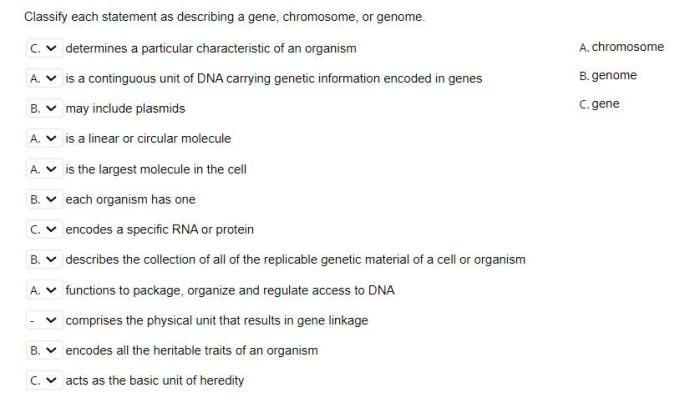Classify each statement as describing a gene chromosome or genome – Classify each statement as describing a gene, chromosome, or genome. This exercise requires an understanding of the fundamental units of heredity and their organization within cells. Genes, chromosomes, and the genome play crucial roles in inheritance and the transmission of genetic information.
Genes are the basic units of heredity, carrying the instructions for specific traits. Chromosomes are thread-like structures that organize and package genetic material within the cell nucleus. The genome encompasses the complete set of genetic information within an organism, including all the genes and regulatory elements.
Gene

A gene is a fundamental unit of heredity that carries genetic information and determines specific traits in an organism. It is a segment of DNA that codes for a specific protein or RNA molecule.
Genes consist of a sequence of nucleotides (adenine, thymine, cytosine, and guanine) arranged in a specific order. This sequence determines the amino acid sequence of the protein or the structure of the RNA molecule that the gene encodes.
Structure and Components of a Gene, Classify each statement as describing a gene chromosome or genome
- Promoter:A region of DNA that initiates transcription, the process of making RNA from DNA.
- Exons:Coding regions of the gene that are translated into protein.
- Introns:Non-coding regions of the gene that are removed during RNA splicing.
- Terminator:A region of DNA that signals the end of transcription.
Examples of Genes and Their Functions
- Insulin gene:Codes for the hormone insulin, which regulates blood sugar levels.
- Hemoglobin gene:Codes for the protein hemoglobin, which carries oxygen in red blood cells.
- Eye color gene:Codes for proteins that determine eye color.
- Centromere:A region of the chromosome that divides it into two arms.
- Telomeres:Protective caps at the ends of chromosomes that prevent their deterioration.
- Chromatids:Identical copies of a chromosome that are joined at the centromere during cell division.
- Mitosis:During cell division, chromosomes are duplicated and separated into two new cells, ensuring that each daughter cell receives a complete set of genetic material.
- Meiosis:During the formation of gametes (eggs and sperm), chromosomes are shuffled and recombined, resulting in genetic diversity.
- Genes:Units of heredity that carry genetic information.
- Chromosomes:Structures that contain genes.
- Non-coding DNA:DNA that does not code for proteins or RNA but plays regulatory roles.
Chromosome: Classify Each Statement As Describing A Gene Chromosome Or Genome

A chromosome is a thread-like structure in the nucleus of a cell that contains genetic material. It is composed of DNA, proteins, and RNA.
Chromosomes are organized into distinct bands and regions that contain specific genes. The number and arrangement of chromosomes are unique to each species.
Structure and Organization of Chromosomes
Role of Chromosomes in Cell Division and Inheritance
Chromosomes play a crucial role in cell division and inheritance:
Genome

A genome is the complete set of genetic material in an organism. It includes all the DNA in the organism’s chromosomes.
Genomes are incredibly complex and vary in size from organism to organism. The human genome, for example, consists of approximately 3 billion base pairs of DNA.
Organization and Complexity of a Genome
Genomes are organized into genes, chromosomes, and other genetic elements:
Relationship between Genes, Chromosomes, and the Genome
Genes are located on chromosomes, and the entire collection of chromosomes constitutes the genome. The genome is the blueprint for an organism’s development and functioning.
Classification
The following statements can be classified as describing a gene, chromosome, or genome:
| Statement | Classification |
|---|---|
| “A unit of heredity that carries genetic information.” | Gene |
| “A thread-like structure in the nucleus that contains genetic material.” | Chromosome |
| “The complete set of genetic material in an organism.” | Genome |
Common Queries
What is the function of a gene?
Genes provide the instructions for specific traits and determine the characteristics of an organism.
What is the role of chromosomes?
Chromosomes organize and package genetic material within the cell nucleus and play a crucial role in cell division and inheritance.
What is the significance of the genome?
The genome encompasses the complete set of genetic information within an organism and determines the organism’s potential for development and function.